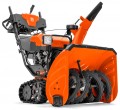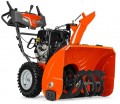Working width
The width of the strip of snow that the snow blower can clear in one pass. The larger the capture width, the fewer passes will be required to process the site, which is especially important on large areas. On the other hand, for processing small spaces, clearing individual paths, etc. significant width is not required (moreover, a “narrow” snow blower will pass more easily in a hard-to-reach place). The larger the capture width, the more powerful the engine, usually, ceteris paribus.
The most compact modern snow blowers have a working width of
less than 50 cm, these are mainly electric models of low power, although gasoline units are also found. A width of
50 – 60 cm can be called relatively small,
60 – 70 cm — medium, and in the largest models this figure
exceeds 70 cm.
Auger / brush diameter
The diameter of the working tool of the snow blower. Other things being equal (primarily engine power), a smaller diameter auger gives more force during rotation, and a larger diameter auger allows you to process more snow in the same time. Therefore, units with large augers can be recommended primarily for working with large volumes of relatively soft snow, and with small ones — for dense packed cover and crust.
Movement
—
On wheels. The most common option among modern snow blowers. Wheeled units turn out to be quite light and manoeuvrable, and problems with cross-country ability can only arise on very rough terrain.
—
On caterpillars. Tracks provide less ground pressure than wheels and a larger contact area. This significantly increases the cross-country ability and allows you to effectively overcome pits, bumps, steep climbs and other difficult places that are “too tough” for wheeled units. On the other hand, tracks are noticeably more complex and expensive than wheels, they can only be used in self-propelled models, and all the advantages become noticeable only on very rough terrain. Therefore, it makes sense to pay attention to caterpillar snow blowers only if maximum cross-country ability is fundamentally important to you.
Number of gears
The number of gears in the transmission of a self-propelled snow blower (see "Design"), in fact — the number of speeds at which it can move during operation.
Recall that upshifting increases speed and reduces torque. Thus, high gears are convenient for working with loose snow, which does not give strong resistance, while low gears allow you to cope with dense snow and crust. And the greater the number of gears, other things being equal, the more accurately you can choose the optimal speed. On the other hand, the abundance of settings complicates and increases the cost of the transmission. Therefore, when choosing the number of gears, manufacturers also take into account the overall level of the snow blower: the more powerful and heavier the unit, the more settings it usually provides.
A separate case are units with continuously variable (including hydrostatic) transmissions. They do not have fixed gears, and the gear ratio is automatically adjusted depending on the throttle position and the load on the working nozzle. One of the advantages of such systems is the almost zero probability of slipping, because. the wheels keep the torque at all times. In addition, the transmission itself can play the role of overload protection: when the auger is jammed, it disconnects it from the engine. On the other hand, stepless systems are quite complex and expensive, and automation does not always work exactly the way the user wants; therefore, this option is relatively rare.
Engine size
The size of the engine installed in a gasoline or diesel (see "Engine type") snow blower. With the same type of internal combustion engine (see above), more displacement usually means more power and more fuel consumption.
Motor power
Snowblower motor power in horsepower.
The universal unit of power today is watts, but for petrol and diesel engines (see "Motor type"), the traditional designation in horsepower may also be given. 1 HP approximately equal to 735 watts.
The higher the motor power, the higher the performance of the snow blower, the better it handles with high dense snowdrifts and icy crust. However, more powerful engines consume more fuel, weigh more and cost more, and their use is not always justified. Detailed recommendations on choosing the optimal power for a specific situation can be found in special sources.
Motor power
Snowblower motor power in watts. This designation is used for all electric models; for units with an internal combustion engine (see "Motor type"), the designation in horsepower may also be given (see above).
The higher the motor power, the higher the snowblower's flow rate, the better it copes with high dense snowdrifts and icy crust. However, more powerful engines consume more fuel, weigh more and cost more, and their use is not always justified. Detailed recommendations on choosing the optimal power for a specific situation can be found in special sources.
Starter
The method of starting motor (see "Motor type") of petrol snow blower. Today, the following options are available:
— Manual (starter rope). The simplest way to start: the operator pulls the cable, which turns the shaft and gives the engine the necessary initial impulse. Such starting systems are the most compact, simple and inexpensive, and they do not depend on power sources. On the other hand, it makes sense to use cables mainly in light and low-power snow blowers - to start heavy units, significant force is required, which is easier to provide with an electric starter.
—
Electric starter (230 V mains). Starting with an electric starter powered by a 230 V network (a regular socket). An electric starter is a small electric motor that turns the engine shaft when starting, giving it an initial impulse. Such systems are more complex, heavier and more expensive than cables, but are suitable even for the heaviest and most powerful engines; and the start itself is extremely simple - the user only needs to press a button. At the same time, power from the network allows you to do without heavy and expensive batteries. True, the network itself is required for starting, but this usually does not cause any special problems; and in case the snow blower stalls "in an open field", a backup starting system is usually provided in the form of the same cable. Therefore, most units with electric starters use power from the network.
...
— Electric starter (battery). Starting with an electric starter powered by a battery installed in the snow blower. For general features of electric starters, see above, and battery power makes the starting system as autonomous as possible: the starter can be used regardless of the presence of sockets nearby, and the battery is recharged from the running engine if necessary. On the other hand, the presence of a battery affects the cost and weight of the unit, and the mentioned autonomy is required relatively infrequently. Therefore, electric starters on batteries are used only in certain models of high-performance snow blowers designed for long-term operation "in the field", away from power grids; the weight and price of the battery in such cases are insignificant compared to the weight and price of the unit itself.Fuel tank volume
The amount of fuel that the snow blower tank can hold at one time. Knowing this figure, as well as fuel consumption (see above), you can easily calculate the approximate operating time on one gas station. However, manufacturers usually choose the volume so that the operating time reaches at least 2 – 2.5 hours, so in most cases you can not pay much attention to this parameter.

